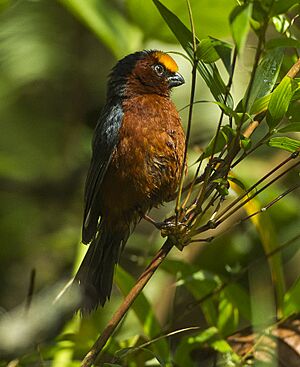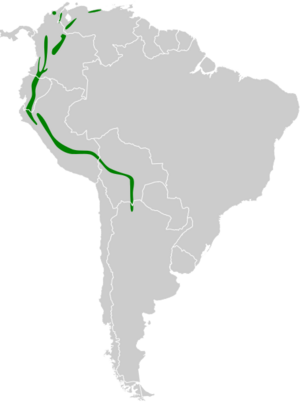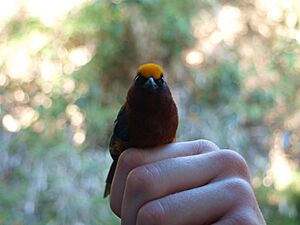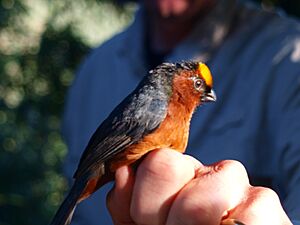Plushcap facts for kids
The plushcap (Catamblyrhynchus diadema) is a special kind of bird in the tanager family, called Thraupidae. It's the only bird in its group, or genus, called Catamblyrhynchus.
This bird is super unique in how it looks and acts, especially compared to other birds in South America. It used to be in its own bird family, but scientists recently decided it belongs with the tanagers. The plushcap has a wide, black beak and a chestnut-colored body. Its most amazing feature is its bright golden-yellow forehead, which looks like a soft, plush cap! This "cap" is made of stiff feathers that might help protect its head when it searches for food. Young plushcaps look like their parents but are a bit duller in color.
Plushcaps live high up in the mountains, from northern Venezuela all the way south to Argentina. This includes the Andes mountains in Colombia, Ecuador, Peru, Bolivia, and northwestern Argentina. They like to live in mountain forests and forests that are growing back, especially where there's lots of bamboo. They hunt for insects inside the bamboo plants. They also eat small insects, berries, and tiny bits of plants.
This bird is very easy to spot and usually isn't confused with other birds. Even though it's a tanager, it looks very different from most of them.
Quick facts for kids Plushcap |
|
|---|---|
 |
|
| Conservation status | |
| Scientific classification | |
| Genus: |
Catamblyrhynchus
|
| Species: |
diadema
|
 |
|
Contents
Meet the Plushcap: A Unique Bird
The plushcap is about 14 cm (5.5 in) long. Male plushcaps usually weigh around 14.9 g (0.53 oz), and females are a bit lighter at about 13.4 g (0.47 oz). Both males and females look very similar, but males are slightly bigger.
Their body is a rich chestnut color, and their famous "plush" cap is a bright golden-yellow. From the back of their neck to their wings, their feathers are black. The special stiff feathers on their forehead might help them when they poke into bamboo to find food. These feathers might be stronger and better at keeping out moisture than regular feathers.
Plushcap Subspecies
There are three main types, or subspecies, of plushcaps:
- C. d. federalis: Found in northern Venezuela.
- C. d. diadema: Lives in northern Colombia, northwestern Venezuela, and southern Ecuador. This is the original type of plushcap.
- C. d. citrinifrons: Found in Peru, Bolivia, and northwestern Argentina. This subspecies has a lighter colored cap.
Where Plushcaps Live
Plushcaps love to live in humid mountain forests. They are almost always found near Chusquea bamboo plants. They live at high elevations, usually between 2,300–3,500 m (7,500–11,500 ft) above sea level. This is where they find their favorite food: insects hidden inside the bamboo.
What Plushcaps Eat
Plushcaps eat a mix of small insects, berries, and other plant parts. They often look for food in small groups, sometimes joining other types of birds.
Their special way of finding insects involves using their strong beaks. They will push and poke their beak into the stems and leaf joints of bamboo plants. They can even pry open parts of the bamboo to get to the insects inside! Sometimes, they will run their beak along the bamboo stems, making tiny biting motions. It's also common to see plushcaps hanging upside down while they search for their next meal.
Plushcap Sounds
Plushcaps are usually quiet birds. But when they do make sounds, they have a long series of chirps and twitters.
Plushcap Conservation Status
The plushcap is considered a species of least concern by conservation groups. This means they are not currently in danger of disappearing. They live across a wide area in South America, and they are quite common in the places where they live. However, scientists believe that the total number of plushcaps might be slowly going down.




